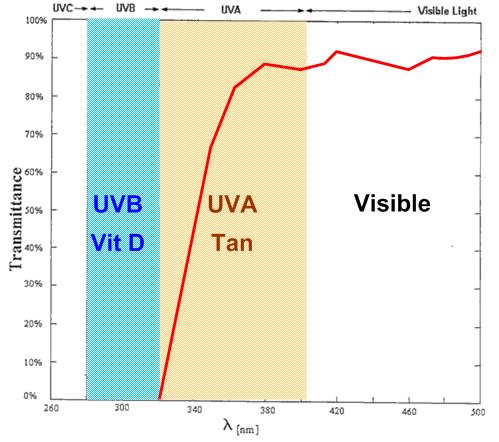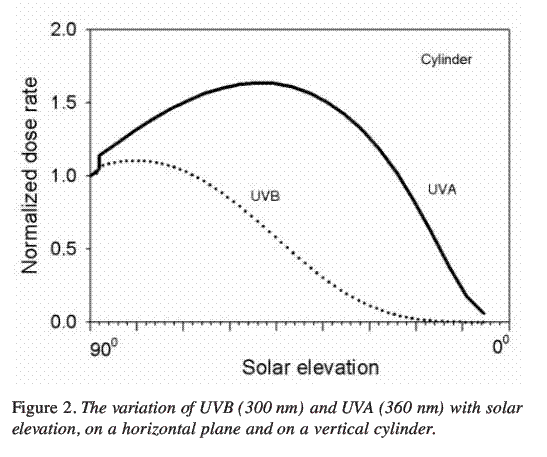UVA decreased vitamin D levels (again)
Phototherapy with UVB narrowband, UVA/UVBnb, and UVA1 differentially impacts serum 25-hydroxyvitamin-D3.
J Am Acad Dermatol. 2013 Jul 11. pii: S0190-9622(13)00539-2. doi: 0.1016/j.jaad.2013.04.058.
Feldmeyer L, Shojaati G, Spanaus KS, Navarini A, Theler B, Donghi D, Urosevic-Maiwald M, Glatz M, Imhof L, Barysch MJ, Dummer R, Roos M, French LE, Surber C, Hofbauer GF.
Department of Dermatology, University Hospital Zurich, Zurich, Switzerland. Electronic address: laurence.feldmeyer@chuv.ch.
BACKGROUND: Ultraviolet (UV) B radiation increases serum 25-hydroxyvitamin-D3 [25(OH)D], but the influence of UVA1 and UVA/narrowband UVB (UVBnb) phototherapy on serum vitamin D is unknown.
OBJECTIVE: We sought to investigate the influence of UVBnb, UVA1, and UVA/UVBnb phototherapy on serum levels of 25(OH)D and related parameters in patients with an inflammatory skin condition.
METHODS: 25(OH)D, as well as calcium, parathormone, phosphate, and albumin were measured before therapy, 2 weeks after start, and after completion of the phototherapy. Diagnoses were divided in 4 groups: atopic dermatitis, psoriasis, morphea, and others.
RESULTS: We surveyed 116 dermatologic patients undergoing phototherapy with UVA1 (n = 38), UVA/UVBnb (n = 30), or UVBnb (n = 48) 2 to 3 times a week for 53 to 90 days. UVBnb phototherapy increased serum 25(OH)D from 22.1 to 39.5 ng/mL after the therapy (P < .001). The lower the baseline 25(OH)D level was, the steeper the increase in 25(OH)D was upon application of UVBnb phototherapy. UVA/UVBnb therapy also increased serum 25(OH)D, from 23.9 to 50.3 ng/mL (P = .003). Conversely, in the UVA1 therapy group, 25(OH)D serum levels decreased significantly from 21.9 to 19.0 ng/mL (P < .001).
LIMITATIONS: The study design was open trial without randomization. An influence of a precise skin disease cannot be excluded because of the heterogeneous diagnoses. Bias may have arisen from patient preference for treatment at our center, referral, unrecognized differences in underlying skin disease, and other factors.
CONCLUSION: Phototherapy with UVBnb and UVA/UVBnb increased 25(OH)D serum level significantly. UVA1 therapy alone induced a reduction in serum 25(OH)D concentrations.
Copyright © 2013 American Academy of Dermatology, Inc. Published by Mosby, Inc. All rights reserved.
KEYWORDS: 25(OH)D, 25-hydroxyvitamin-D3, DLQI, Dermatology Life Quality Index, UV, UVBnb, inflammatory skin disease, narrowband ultraviolet B, open observational study, phototherapy, ultraviolet, ultraviolet A, ultraviolet B, vitamin D
PMID: 23850091
Summary by VitaminDWiki
|| |Before|After
UVA only |22 ng|19 ng
UVA + UVB narrowband|24 ng|50 ng
UVB narrowband| 22 ng|40 ng ||
NOTE: differences between lines 2 and 3 may have been due to intensity differences - no indication in abstract
See also VitaminDWiki
US truckers die 16 years sooner (UVA-low Vitamin D, obesity, little exercise from being behind windowglass so much
UVA from some tanning beds and most windows decrease vitamin D blood levels – March 2012 which has the following:
- The UVA which gets thru glass might DECREASE vitamin D levels

Overview Skin and vitamin D which has the following graph UV when standing at 45 degrees

Wonder if the high ratio of UVA to UVB in the late afternoon DECREASES the vitamin D levels
Increased UVA exposures and decreased cutaneous Vitamin D-3 levels may be responsible for the increasing incidence of melanoma
February 2009Medical Hypotheses 72(4):434-43, DOI: 10.1016/j.mehy.2008.09.056
Dianne Godar Robert J Landry Anne D Lucas Anne D Lucas
References (120)
Cutaneous malignant melanoma (CMM) has been increasing at a steady exponential rate in fair-skinned, indoor workers since before 1940. A paradox exists between indoor and outdoor workers because indoor workers get three to nine times less solar UV (290-400 nm) exposure than outdoor workers get, yet only indoor workers have an increasing incidence of CMM. Thus, another "factor(s)" is/are involved that increases the CMM risk for indoor workers. We hypothesize that one factor involves indoor exposures to UVA (321-400 nm) passing through windows, which can cause mutations and can break down vitamin D(3) formed after outdoor UVB (290-320 nm) exposure, and the other factor involves low levels of cutaneous vitamin D(3). After vitamin D(3) forms, melanoma cells can convert it to the hormone, 1,25-dihydroxyvitamin D(3), or calcitriol, which causes growth inhibition and apoptotic cell death in vitro and in vivo. We measured the outdoor and indoor solar irradiances and found indoor solar UVA irradiances represent about 25% (or 5-10 W/m(2)) of the outdoor irradiances and are about 60 times greater than fluorescent light irradiances. We calculated the outdoor and indoor UV contributions toward different biological endpoints by weighting the emission spectra by the action spectra: erythema, squamous cell carcinoma, melanoma (fish), and previtamin D(3). Furthermore, we found production of previtamin D(3) only occurs outside where there is enough UVB. We agree that intense, intermittent outdoor UV overexposures and sunburns initiate CMM; we now propose that increased UVA exposures and inadequately maintained cutaneous levels of vitamin D(3) promotes CMM.
92 citations of the study in Google Scholar as of June 2018
Addition of UVA to UVB decreased the amount of Vitamin D generated - RCT 2016
Vitamin D levels after UVB radiation: effects by UVA additions in a randomized controlled trial.
Photodermatol Photoimmunol Photomed. 2013 Dec;29(6):323-9. doi: 10.1111/phpp.12076. Epub 2013 Oct 30.
Sallander E1, Wester U, Bengtsson E, Wiegleb Edström D.
BACKGROUND: Ultraviolet B (UVB) radiation increases the serum level of 25-hydroxyvitamin D [25(OH)D]. However, the impact of UVA on vitamin D synthesis by UVB is poorly understood clinically.
OBJECTIVE: To examine how different combinations of UVA and UVB radiation affect S-25(OH)D for the same vitamin D-weighted exposure.
MATERIALS AND METHODS:
Healthy participants were recruited and subsequently divided into four comparable groups regarding initial 25(OH)D value. The different radiations given were whole-body UVB (n = 23), UVAB (n = 23) and UVA (n = 10). The controls (n = 19) had no intervention. The exposure times were chosen to give the same calculated vitamin D effective dose (suberythemal exposures ≤1 standard erythema dose). Blood samples were collected before the first irradiation (t0), immediately after the last (fifth) irradiation (t1) and then after another 2 days after the last (fifth) irradiation (t2).
RESULTS: UVB and UVAB radiation significantly increased 25(OH)D levels. In the UVA group the increase was less with the same vitamin D-weighted radiation dose.
CONCLUSIONS: Short sessions of UVB or UVAB radiation with the same vitamin D-weighted exposure increased 25(OH)D levels. The UVA dose does not influence 25(OH)D levels under short exposure times. However, there was a significantly lower increase of 25(OH)D levels during longer UVA irradiation (≥9 min) .
